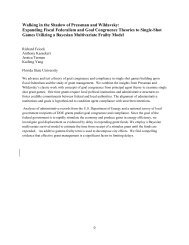STRATEGIC NETWORKS Ranjay Gulati, Nitin Nohria, Akbar Zaheer ...
STRATEGIC NETWORKS Ranjay Gulati, Nitin Nohria, Akbar Zaheer ...
STRATEGIC NETWORKS Ranjay Gulati, Nitin Nohria, Akbar Zaheer ...
You also want an ePaper? Increase the reach of your titles
YUMPU automatically turns print PDFs into web optimized ePapers that Google loves.
are sometimes spelled out in formal contracts, most often they are simply understandings thatevolve within the dyad and the network (Laumann, Galaskiewicz, & Marsden, 1978)There are numerous structural network characteristics that can affect the profitability ofthe firms in an industry. Network scholars have identified various factors such as networkdensity, structural holes, structural equivalence, and core versus peripheral firms, each of whichcan affect the profitability of industries and of the firms within them. For instance, denseinterfirm ties within the industry may be conducive to oligopolistic coordination, tacit orotherwise (Scherer and Ross, 1990). Research by Eccles and Crane (1988) and Podolny (1993)vividly shows how the ties among the top-tier investment banks sustain the high returnscharacteristic of that industry. Similarly, research by Baker and Faulkner (1991) shows howchanges in the pattern and density of ties in the US movie industry over the years has influencedthe rate of entry and profitability of the firms in the industry.Structural holes can be another important factor in influencing industry returns. Theyexist when two industry trading partners are connected only through the focal industry. Structuralholes in an industry’s customer-supplier network may confer power through control, andultimately profitability. Based on an analysis of input-output tables that define the network offlows among industries, Burt (1992) has shown that industries that occupy structural holes enjoygreater returns by being able to appropriate a larger share of the resources that flow throughthem.Network membership also influences the location of an industry in a broader network ofresource flows that might influence its profitability. For example, the status of the alters (i.e. theindustries the focal industry is tied to) can influence the focal industry’s profitability. One needlook no further than the declining fortunes of defense contractors (supplying a contracting7




